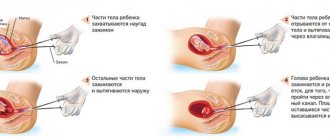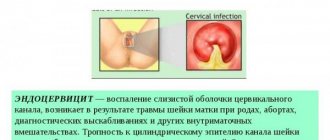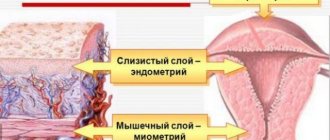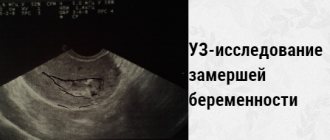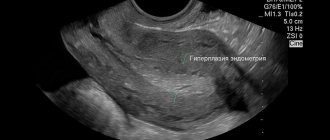The uterus does not contract after childbirth
During 9 months of pregnancy, the uterus increases in size by more than 500 times, and after childbirth it gradually returns to its previous state.
This organ undergoes the greatest changes compared to the entire woman’s body. But all this does not happen in one day. Immediately after the expulsion of the placenta in the postpartum period, the uterus begins to contract, decreasing in size. In this process, it is cleansed of blood and remnants of the child's place. In different women, the return of the uterus to its previous state occurs differently and may take different time periods. In addition, there are a number of factors that promote or prevent faster uterine contractions. In particular, everyone knows that when a baby sucks the breast, the woman’s body releases the hormone oxytocin, which tones the uterus, enhancing its contractile activity.
On average, it takes 1.5-2.5 months for the uterus to return to its pre-pregnancy size. The uterus contracts most actively in the first days after birth, losing about half of its weight in the first week. This process is accompanied by cramping pain in the lower abdomen, which is more pronounced and intense after repeated births. But it happens that the uterus does not contract after childbirth or contracts very slowly. More precisely, it is the reduced ability of the uterus to contract (hypotony of the uterus) that most often occurs, and complete paralysis of the uterine muscles (atony) is less common.
Why doesn't the uterus contract after childbirth?
Thus, uterine contractions may occur more slowly if the pregnancy was multiple, occurred with complications (preeclampsia, nephropathy, hypertension), placenta previa or low attachment occurred, the woman’s body and nervous system are exhausted, the baby is quite large, labor was weak, the woman after labor practically does not move
Source
Ginestril
Ginestril is a medication designed to improve uterine contractions by blocking the production of the hormone progesterone.
There are many contraindications to taking Ginestril, as with other hormonal drugs. In particular, it will be prohibited for use in cases of severe anemia, as well as inflammation of the reproductive system.
Tablets are prescribed with caution for pulmonary pathologies, asthma and heart rhythm disorders.
Women tolerate the medicine quite well. In rare cases, symptoms of urticaria develop. Nausea and a feeling of general malaise may develop.
How long does the uterus contract after childbirth?
During pregnancy, many changes occur : the mammary glands swell, hormonal changes make themselves felt, and, of course, the baby grows, and with it the uterus increases in size.
This organ is unique in its properties, because during pregnancy the uterus increases in volume by more than 500 times. Well, after the birth of a child, it begins to gradually decrease.
Due to the fact that each person's body is unique, the return of the uterus to its original size in women takes different times. However, there are a number of factors that can promote or, on the contrary, hinder its faster reduction.
How does the uterus contract?
After childbirth, the inside of the uterus is a huge wound, and it is most damaged in the area where the placenta was attached, which is where a large number of thrombosed vessels are located. In addition, on the inner surface of the uterus there are remnants of the fetal membrane and blood clots.
Normally, the uterine cavity should clear out within the first 3 days. In this process, a significant role is played by phagocytosis (phagocytes are leukocytes that are capable of dissolving bacteria) and extracellular proteolysis (dissolution of bacteria using proteolytic enzymes).
Thanks to these processes, wound secretion (lochia) is released from the uterus. In the first days, lochia appears as bloody discharge, on the 3-4th day it becomes serous-sucrose with a high content of leukocytes, by the end of the third week, the uterine discharge should be liquid and light and disappear completely by the sixth week.
Moreover, if we talk about the restoration of the epithelium of the uterine cavity (inner lining), then it occurs after about 3 weeks, the placenta is attached to
Source
The uterus has not contracted
The birth was natural, but with strong gaps. A month after giving birth, I was observed by a gynecologist (sutures, treatment, etc.). Then I saw a doctor only at 8 months. The doctor said that the uterus had not contracted.
When asked how the situation could be corrected, she said that physical activity was needed. I started pumping up my abs and doing exercises for about 30 minutes a day. There is no result (my stomach did not retract).
Please help us make the site better! Leave a message and your contacts in the comments - we will contact you and together we will make the publication better!
Good afternoon. Don’t worry so much, there is no danger. For each woman, the postpartum recovery period takes a different time. On the contrary, breastfeeding promotes rapid contraction of the uterus, so feed your baby as much as necessary.
But you should still see a gynecologist. It is quite possible that lochia or part of the placenta remains in the uterine cavity and it is because of this that the uterus does not contract and then cleaning will have to be done. Read here https://puziko.online/posle-rodov/oslozhneniya/ne-sokrashhaetsya-matka-posle-rodov.html.
Perhaps you have a kinked uterus or had some illnesses before pregnancy. Change your doctor, find an experienced specialist. You may need surgery. It seems to me that if the uterus has not yet contracted, physical exercise or advice to lie on your stomach will not help. But breastfeeding, on the contrary, helps.
Actually, this is already a cause for concern! Firstly, you cannot treat your health this way; if after the first month there were problems, then you should visit the doctor monthly. Secondly, ask the doctor to do an ultrasound and refer you for tests, in the end you can find another specialist... but don’t leave this matter for later, physical activity
Source
Borovaya uterus after a frozen pregnancy
Recovery after a frozen pregnancy
A frozen pregnancy is a tragedy for the whole family, leaving an imprint on everything. This happens to women at very different ages, not necessarily mature or too young. There are many factors and circumstances that contribute to this problem, and every expectant mother should be warned about the signs of fetal failure.
However, today the “Sunny Lady” would like to talk about recovery from a frozen pregnancy . how the uterus behaves, how long a woman’s rehabilitation lasts. Just don’t try to look for all the signs of impending danger; a frozen pregnancy is a fairly rare case.
In medicine, both a miscarriage and a frozen pregnancy are considered one problem, implying the death of the fetus. Usually in this case the uterus does not push out the fetus for some reason, delaying it for a month or even two.
The reasons for both cases are the same. Therefore, recovery after a frozen pregnancy will be approximately the same as after a miscarriage (as well as prevention and treatment).
To begin with, it must be said that the first such case is not yet an indicator. This can be simply an accident embedded in the complex process of conceiving and bearing a child. But if 2-3 cases of frozen pregnancy or miscarriage occur, then we can already talk about pathology and the beginning of treatment.
During the recovery period, women will begin to think - what to do now? How will this affect future children and will they be able to have them? Doctors reassure that the consequences of a frozen pregnancy are uncomplicated, and in most cases a woman will cope well with the role of a mother in the future. For some, they are prescribed to take a red brush or hog uterus for conception.
Consequences
Since curettage during a frozen pregnancy is done using instruments that injure the uterine mucosa, negative consequences cannot be avoided. You will have to give up planning for a child for a while. The doctor determines exactly what kind of break is required individually. Everything depends on the success of the operation and the body’s recovery resources. Read more about pregnancy after curettage →
As a rule, the minimum period is six months. During this time, it is necessary to use contraception and avoid unnecessary worries: fears about further inability to bear a child are most often not justified, and a state of stress slows down the healing process of the uterine mucosa.
Psychological trauma is one of the most common consequences of frozen pregnancy and curettage. Therefore, after a woman returns home, the support of relatives, especially her husband, is very important. It is necessary to switch her attention from worries about what happened to future favorable events: the opportunity to become pregnant again.
During a six-month or longer break, you need to concentrate on your health: eat right, exercise, get enough sleep. In severe cases, when it is not possible to cope with feelings with the help of loved ones, it is worth contacting a psychologist or psychotherapist.
To minimize the risk of another miscarriage, both spouses need to undergo a medical examination. The cause of pathology can be not only disorders in the female body, but also in the male. Read more about pregnancy planning for men →
Life after a frozen pregnancy
Life after a frozen pregnancy is not easy. A frozen pregnancy often goes unnoticed. Therefore, all women should know about this condition.
Menstruation after a frozen pregnancy
Menstruation after a frozen pregnancy should begin on time. In principle, a delay in menstruation of up to 45 days is considered normal. The delay is due to the stress that the woman has experienced. It takes time to restore the cycle. Sexual activity is not advisable before the first menstruation occurs.
This can happen if parts of the fertilized egg remain in the uterus. Be sure to undergo a control ultrasound 10 days after curettage.
Discharge after a frozen pregnancy
Discharge after a frozen pregnancy is normal. During curettage, the endometrium is partially removed from the uterus. Removing the fertilized egg without bleeding is not possible. Bleeding usually lasts 3-4 days. After 10 days you will have an ultrasound to see if everything is okay. Sharp painful sensations should prompt a woman to contact a gynecologist ahead of schedule.
Brown discharge after a frozen pregnancy, starting later than 2 weeks after curettage, should alert you. They may be signs of inflammation. If heavy brown discharge after a frozen pregnancy is also accompanied by pain and a rise in temperature, you need to go to the doctor immediately!
Abdominal pain after frozen pregnancy
Abdominal pain after a frozen pregnancy is observed as a reaction to injury during curettage. Short-term cramping pain is also possible.
thrush during pregnancy soda solution The scientific name for thrush is “Candidiasis”. This disease occurs due to the activation of yeast-like fungi, which are the cause of inflammatory processes that affect some human organs, including
Pain in the lower abdomen in the absence of discharge may indicate the development of a complication in which blood is retained in the uterine cavity. If there is pain and bleeding, this may also indicate injury to the uterine wall (per
Source
Hello, dear Elena Petrovna and girls! I beg you not to ignore my problem. I am 41 years old and have a healthy 18 year old child. In November 2014, my pregnancy miscarried at 9 weeks. Cleaned 3(!) times, because... the uterus contracted poorly. Genetic analysis of the fetus showed chromosomal mutation 47xx. The geneticist with whom I subsequently consulted said that this was a spontaneous mutation and the risk of recurrence was 1% (age-related). My main problem now is the lack of periods! Already 4 months! At first I wasn’t very worried; after all, such an aggressive intervention in the uterus and age. I ran to the doctor when 60 days had passed after the cleansing. I did an ultrasound, everything was normal, even ovulation was in the right ovary. The doctor said to wait another week and if menstruation does not start, take Duphaston for 7 days. That's what I did! 10 days after stopping duphaston, nothing started. I'm going to the doctor again. She sent me for tests. Here is the result of FSH 2.03 mIU/ml, LH 6.44 mIU/ml, Estradiol 653 pmol/l. The doctor said that this is not menopause, there is not enough estrogen and prescribed Femoston 2/10. After it, according to the doctor, menstruation should definitely begin. I took it, 10 days have passed since the last pill, but still nothing. I no longer know where to run, what medications to take, and generally in what direction to move... I re-read all the materials on this site, watched the video. Everything is very accessible and understandable! Thank you very much for your tremendous work!!! Sorry for the many words, you're just the last hope! Information just in case: my height is 164 cm, weight 64 kg, my periods have always been regular since I was 14 years old. During this pregnancy, I became pregnant on my own, without stimulation, after 4 months of planning, but, unfortunately, I froze. I hoped that I would wait until my period and I could try again, but somehow it didn’t work...
Comments on this post
cramps in the calves at night, cause and treatment during pregnancy. Almost all pregnant women experience leg cramps from time to time. Doctors are quick to assure that there is nothing wrong with this, but this does not in any way alleviate the suffering at the time of a cramp. Let's consider the causes of seizures
If you cleaned it three times, then most likely you have Asherman syndrome
Source
Exercises to contract the uterus after curettage - bleeding after cleaning the endometrium
Curettage (curettage) is a procedure for removing part of the endometrial layer. Curettage is performed for diagnostic and therapeutic purposes.
In the first case, endometrial cells are sent to the laboratory to be examined for the presence of atypical elements.
Diagnosis of the inner layer of the uterus is necessary in case of severe bleeding for an unknown reason, as well as in the detection of tumors on the endometrium. In this case, the gynecologist uses a hysteroscope to examine the organ and makes scrapings.
As a therapeutic measure, cleaning is carried out in the following situations:
- inflammation of the endometrium;
- polyps;
- bleeding, including during menopause;
- menstrual irregularities;
- pathologies of the cervix;
- miscarriage;
- frozen pregnancy;
- consequences of an unsuccessful abortion;
- the presence of placenta particles in the uterus after childbirth.
Before curettage, it is necessary to perform an OAC, a blood test for coagulation, and a smear examination of the vaginal flora. Three days before the procedure, you should stop using vaginal suppositories, intimate hygiene products, gels, ointments, etc.
Two days before the procedure, it is necessary to exclude sexual contact. If a woman is taking medications, you should tell your doctor about this: their use may need to be reduced or discontinued.
On the day of surgery, you should limit the amount of food and liquid you consume.
The procedure consists of several stages:
- The patient lies down in the gynecological chair. The doctor administers a local anesthetic to eliminate pain during the procedure.
- A speculum and a hysteroscope are inserted into the cervix. The gynecologist examines the walls of the uterus, assessing their condition.
- Curettage is carried out using a special medical instrument, similar to a small spoon with a long handle - a curette. This device cuts off excess endometrial tissue or removes the remains of the embryo after an artificial termination or a frozen pregnancy.
Upon completion of the procedure, patients feel pain in the lower abdomen, which can last for several days. This is a normal phenomenon: the uterus contracts, cleaning itself. Analgesics can be used to reduce pain.
Also, over the course of several days, clots may be released, which decrease every day and after about 10 days should disappear completely.
After the operation is completed, sexual intercourse should be avoided for a month.
If bleeding after curettage does not stop after 10 days and pain remains in the uterus and lower back, this may indicate the presence of complications. In this case, you should not delay your visit to the gynecologist.
Curettage can cause the following complications:
- Heavy scarlet bleeding (in an hour a large pad is completely filled) with a large number of clots, accompanied by severe or moderate pain in the uterine area. In this case, paleness of the skin and loss of consciousness are possible. In such cases, there will be no brown discharge, since the symptoms indicate that the patient has problems with blood clotting. This situation requires emergency medical attention. To prevent such cases, a blood clotting test is done before surgery.
- Hematometra is a situation where blood cannot leave the uterus. This picture is usually observed with cervical spasm. Signs of hematometra are an increase in temperature from 37°C, an unpleasant odor from the vagina, severe pain in the lower abdomen, radiating to the lower back. A mandatory symptom is that in the first days after the procedure, the discharge is scanty or absent at all.
- Inflammation of the endometrium. This complication is accompanied by a temperature much higher than 37°C – values can reach up to 39°C. In this case, the patient experiences chills, pain in the lower abdomen, and general malaise. Endometritis develops as a result of the proliferation of pathogenic microorganisms on the inner layer of the uterus. Yellow discharge is possible. This situation also requires hospitalization and drug therapy.
- Infertility. The most rare complication, almost never encountered in women who have undergone uterine cleansing.
Upon completion of curettage, complications do not arise provided that the patient follows all the doctor’s recommendations. During the recovery period, you cannot perform heavy physical work or play sports.
It is important to take medications prescribed by the gynecologist (analgesics, hemostatic agents, antibiotics to avoid fever and the proliferation of pathogenic bacteria after curettage).
Gynecologists advise waiting to conceive after an abortion or a frozen pregnancy for at least six months. Why so long? The body needs this period for rehabilitation.
It is important to wait until the menstrual cycle is restored and the reproductive system is functioning properly. This time can be used for active preparation for pregnancy, including giving up bad habits, taking folic acid, and leading a healthy lifestyle.
In this way, you can increase the chances of conceiving again as quickly as possible and bearing a healthy child.
Discharge after therapeutic cleansing of the uterus ends within 10 days. If this does not happen, hemostatic drugs are prescribed.
Restoring the menstrual cycle takes several months, and you can start conceiving six months after an abortion or curettage.
Recommendations
Recovery after curettage has a number of normal characteristics. If there is a deviation from the norm, it is recommended to immediately consult a doctor. Normally, during this period the following may be present:
- Pain in the lower abdomen associated with contraction of the uterus after curettage;
- Minor bleeding;
- Feelings of nagging, aching pain in the back.
Such symptoms may be present only in the first few days. If it persists after a week, then you need to consult a doctor. You should also do this if there is heavy bleeding and excessively intense pain, or if you have a fever after cleaning the uterus.
During this period, it is necessary to reduce physical activity, which will have a good effect on your well-being. You cannot steam in the bathroom; hygiene must be maintained with the help of a shower.
At the same time, it is better not to use chemical products for intimate hygiene, medications administered vaginally, tampons and douches.
Avoid overheating - do not visit saunas, steam baths, solariums, the beach, do not swim in open reservoirs and pools, carefully observe hygiene.
Drugs
Treatment after curettage of the uterine cavity involves taking medications.
They are not aimed at directly promoting the growth of the endometrium, since this is not necessary - this is a natural process that occurs physiologically.
The medications are taken in order to improve the patient’s condition and well-being, avoid relapses of the disease, and also prevent the development of severe consequences and complications, such as infection.
Antispasmodics
Antispasmodics after uterine curettage should be prescribed with caution. This is due to the fact that after this procedure the uterus contracts, pushing out excess endometrium and rejecting its remains. This is a normal physiologically determined process in this situation, but it causes quite severe pain in the lower abdomen, which persists in the first days after the intervention.
It can cause quite severe discomfort to the patient, but it is not advisable to relieve it with antispasmodics, because if the uterus does not contract, the healing process may be delayed. In severe conditions, No-shpa and other drugs are prescribed.
Diagnostic curettage
Antibiotics
Antibiotics are always prescribed after curettage of the uterine cavity. They are taken in a course of five to ten days, one or two tablets per day, depending on the selected drug. Depending on the patient’s condition, the course may begin on the day of cleaning or a day or two earlier.
Why are antibiotics prescribed at all? It is necessary to drink them in order to avoid any concomitant infection.
To prevent this, strong broad-spectrum antibiotics are prescribed, such as Tsiprolet, Ceftriaxone, Amoxiclav, etc.
How to restore the uterus after curettage? In general, it is able to recover on its own; this is a normal process, similar to the restoration of the endometrium after menstruation, when it is almost completely rejected and renewed. The growth of the mucous layer within the cycle and after curettage occurs under the influence of the hormone estrogen produced by the ovaries. The more it is, the more actively the endometrium grows.
Estrogen preparations can cause hormonal imbalance, but the use of herbs rich in phytoestrogens (plant analogues of estrogen) has a very beneficial effect. You can drink decoctions and infusions from boron uterus and red brush. Borovaya uterus after curettage is especially indicated, as it contains more phytoestrogens than other herbs.
Anti-inflammatory drugs are not always prescribed, but in most cases they are still indicated. They are needed for approximately the same thing that antibiotics are needed for - to prevent the development of the inflammatory process on the wound surface.
Drugs such as Nurofen and Ibuprofen are prescribed, which are taken 2-3 tablets per day for a week, starting from the day of the procedure. For the same period, Diclofenac can be prescribed by injection.
If a temperature appears after curettage, this may indicate the onset of an inflammatory process. Therefore, it is necessary to immediately consult a doctor.
Uterus after childbirth
From the moment of birth of the placenta (fetal membranes, umbilical cord, baby's place) the postpartum period begins. There are early (within 2 hours after birth) and late (6-8 weeks) postpartum periods. This is an important stage in a woman’s life, during which the entire body undergoes a restructuring, namely, the reverse development of changes that were associated with pregnancy and childbirth. The only exception is the mammary glands, the function of which is only gaining momentum for the establishment of lactation. The most obvious changes occur in the reproductive system and primarily in the uterus. After all, from the huge “fruit container” it must again take on dimensions smaller than the size of its own fist.
information The uterus is a smooth muscle hollow organ consisting of the body (about 4-5 centimeters) and the cervix (about 2.5 centimeters in size). In its shape it resembles an inverted pear. This organ differs from all other muscular organs of the body in its unique ability to stretch to accommodate a full-term baby. All this is ensured by a special interweaving of muscle and connective tissue fibers, a rich blood supply and the action of a number of hormones during pregnancy.
Contraction of the uterus after childbirth
So, having reached its maximum size before childbirth, the uterus undergoes a number of changes in order to return to the state it was in before pregnancy (or almost to it). Immediately after the birth of the child and placenta, the uterus sharply decreases in size. Its bottom becomes 2 centimeters above the level of the navel, it is often shifted to the right, has a dense structure, and the cavity is filled with a small amount of blood. Every day the fundus of the uterus shifts by 1-2 centimeters; on days 5-7, the uterus almost completely descends into the pelvis. The weight of the uterus decreases from 1000 grams immediately after birth to 500 - after one week, to 325 - by the end of the second
Source
Pregnancy after curettage
Doctors do not recommend planning conception within six months after curettage, which is associated with physical and emotional recovery after the operation. Hormonal drugs are often prescribed. Carrying a fetus after curettage is a big burden on a woman’s body. Often, attempts to conceive earlier than 6 months can result in spontaneous termination of pregnancy in the early stages or the formation of defects in the development of the fetus. An immature woman may also not carry the baby to term and give birth prematurely.
Thus, curettage removes the fertilized egg. The operation allows you to maintain the health of your reproductive organs. It is painless due to the administration of intravenous anesthesia. The period of recovery of the body and the onset of the first menstruation occurs within 30–40 days. Doctors recommend planning pregnancy no earlier than six months after surgery.
